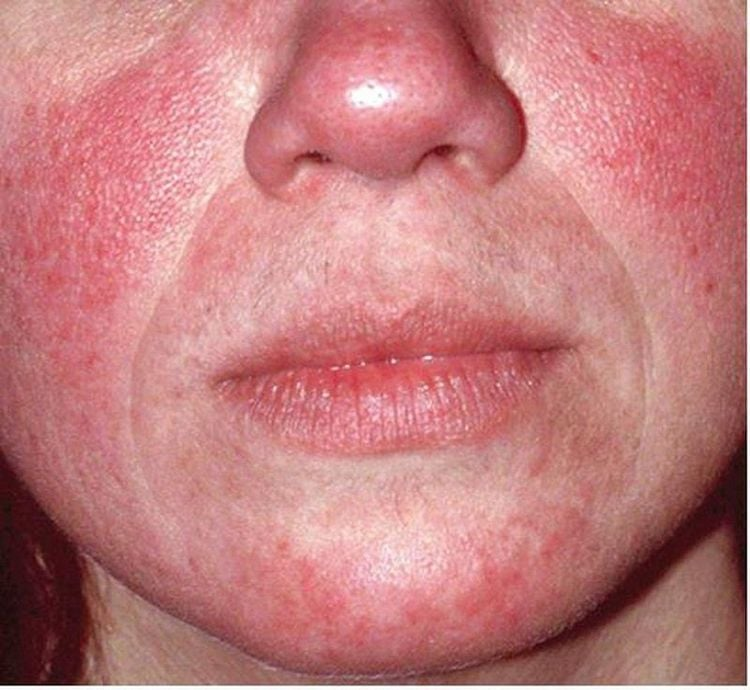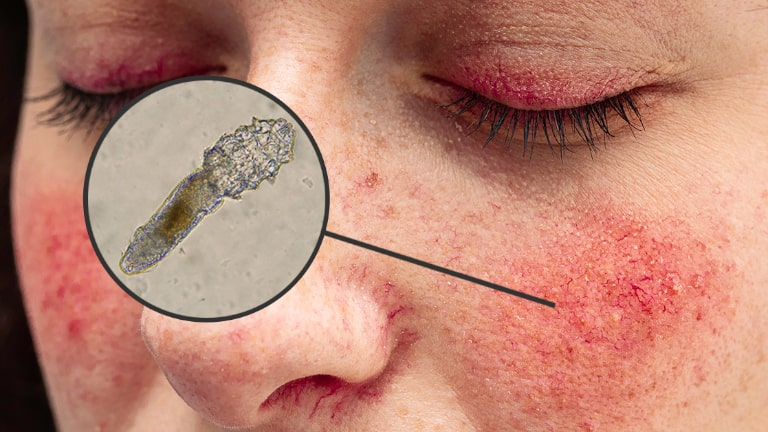Demodex dermatitis is a skin condition caused by Demodex mites, microscopic arthropods that parasitize humans and animals. These mites inhabit sebaceous follicles and hair follicles, and while they are a normal part of the skin microbiome, an overpopulation can trigger a range of skin issues. Understanding the causes, symptoms, and treatment options for Demodex dermatitis is essential for managing this condition effectively.

What Are Demodex Mites?
Demodex mites are tiny parasites that live in the sebaceous (oil) glands and hair follicles of mammals. In humans, two primary species are responsible for Demodex dermatitis:
- Demodex folliculorum: Larger in size, with adults reaching up to 440 micrometers (μm). This type is primarily found in hair follicles.
- Demodex brevis: Smaller, measuring up to 240 μm. This species resides in sebaceous glands.
These mites are invisible to the naked eye and can only be observed under a microscope. Their life cycle spans 14 to 24 days and includes five stages: egg, larva, pre-pupa, pupa, and adult. Demodex mites usually live in pairs, mate on the skin, and lay eggs within follicles or sebaceous glands. After dying post-reproduction, their decomposing bodies can trigger immune reactions, leading to symptoms such as redness, inflammation, and dermatitis.
How Does Demodex Dermatitis Spread?
Demodex dermatitis spreads through direct contact and contaminated surfaces. Common transmission methods include:
- Direct Skin Contact: Hugging, kissing, or touching.
- Shared Personal Items: Towels, pillowcases, or makeup brushes.
- Airborne Particles: Dust containing eggs may adhere to the skin surface.
The risk of infestation increases in environments where skin hygiene is compromised or immunity is weakened.
Developmental Life Cycle of Demodex Mites
Understanding the life cycle of Demodex mites is key to effective treatment:
- Egg Stage: Eggs are laid in hair follicles or sebaceous glands.
- Larva Stage: Eggs hatch into larvae with three pairs of legs.
- Pre-Pupa and Pupa Stages: Larvae molt and develop into pupae with four pairs of legs.
- Adult Stage: Fully grown mites reproduce and repeat the cycle.
This entire process occurs within a few weeks, emphasizing the importance of early intervention to prevent rapid population growth.

Types of Demodex Dermatitis
Demodex dermatitis manifests in three primary forms, depending on the severity and location of the infestation:
1. Folliculitis (Mild Type):
- Characterized by red patches of skin with scales or plugs in hair follicles.
- Patients often describe a crawling sensation, as if ants are moving on their skin.
2. Acne-Like Demodex Dermatitis:
- Resembles acne with pustules and papules.
- Commonly misdiagnosed as standard acne, particularly in adolescents.
3. Granulomatous Rosacea (Severe Type):
- Rare but occurs in individuals with compromised immunity.
- Presents as thickened, red, and inflamed skin, often mistaken for rosacea.
Symptoms of Demodex Dermatitis
The symptoms of Demodex dermatitis vary based on the severity of the infestation. Key indicators include:
- Red Patches and Papules: Inflamed, irritated areas on the face or body.
- Pustules: Small, pus-filled bumps that resemble acne.
- Itching and Crawling Sensation: Particularly noticeable at night when mites are most active.
- Dilated Blood Vessels: Prominent capillaries on the nose, cheeks, or forehead.
- Facial Redness and Skin Roughness: Chronic inflammation can lead to long-term skin changes.
- Eyebrow and Eyelash Loss: Mites can affect hair follicles, causing noticeable thinning.
- Hair Loss and Scalp Itching: In some cases, mite activity extends to the scalp, leading to discomfort and hair shedding.
Common Causes of Demodex Dermatitis
Several factors can trigger an overpopulation of Demodex mites:
- Weakened Immunity: Individuals with compromised immune systems are more susceptible to infestations.
- Use of Corticosteroid-Containing Cosmetics: Long-term use of unverified products can weaken the skin’s natural defenses, promoting mite proliferation.
- Oily Skin: Sebum-rich environments provide ideal conditions for mites to thrive.
- Poor Hygiene: Neglecting daily cleansing routines can lead to mite overgrowth.

How to Treat Demodex Dermatitis
Effective treatment focuses on eliminating the mites, restoring skin health, and preventing reinfestation. Below are key treatment principles and steps:
1. Remove Mites from the Skin Surface
- Use topical medications prescribed by your dermatologist, such as permethrin or metronidazole.
- Cleanse your skin daily with mild, non-comedogenic products to reduce sebum and bacteria.
2. Limit the Use of Cosmetics
- Avoid oil-based products and makeup during treatment, as these can create environments where mites multiply quickly.
3. Follow Good Hygiene Practices
- Wash bedding, towels, and makeup brushes regularly in hot water.
- Avoid sharing personal items to reduce the risk of spreading mites.
4. Exfoliate Regularly
- Gently exfoliate to remove dead skin cells and unclog hair follicles, creating a less hospitable environment for mites.
5. Use Medications as Prescribed
- Follow your doctor’s recommendations for oral or topical treatments.
- Treatment durations vary, so consistency is key to success.
Preventing Demodex Dermatitis
While treatment is essential, prevention can save you from the discomfort and frustration of dealing with Demodex dermatitis. Here’s how to protect yourself:
- Maintain a Clean Skincare Routine: Cleanse your face twice daily with gentle, sulfate-free products.
- Avoid Unverified Skincare Products: Always check for reputable sources and avoid long-term use of corticosteroid-based cosmetics.
- Monitor for Early Signs: Seek medical advice if you experience persistent redness, itching, or papules.
- Boost Immunity: A healthy lifestyle, including a balanced diet and adequate sleep, helps your body defend against infestations.
Why Early Treatment Matters
Demodex dermatitis is highly contagious and can spread quickly if left untreated. Early intervention not only minimizes symptoms but also reduces the risk of severe complications, such as granulomatous rosacea or long-term scarring.
Conclusion: Take Action Against Demodex Dermatitis
Demodex dermatitis, though often misunderstood, is manageable with prompt diagnosis and proper care. By recognizing the signs early, adopting good hygiene habits, and following prescribed treatments, you can effectively combat this condition. Don’t let Demodex mites wreak havoc on your skin—take control of your health and consult a dermatologist if you suspect an infestation. A proactive approach ensures your skin stays healthy, radiant, and mite-free.


